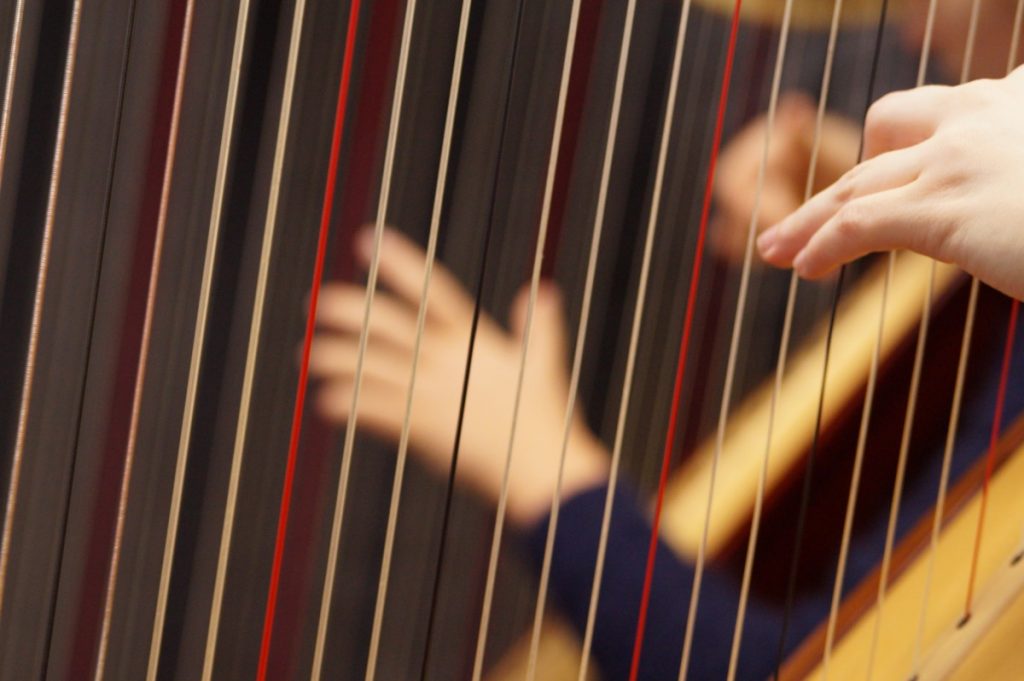Milwaukee Musaik Concert Stars the Harp
20th century works by Still and Bonis featuring the harp, paired with Brahms piano quartet.
Milwaukee Musaik describes itself as “a consortium of musicians dedicated to an imaginative concert experience.” The organization brings its signature blend of familiar classical music and lesser-known gems to the Sharon Lynne Wilson Center for the Arts on Sunday, March 19. Seven performers will take the stage: Heather Zinninger (flute), Kelsey Molinari (harp), Jeanyi Kim and Alexander Mandl (violin), Nathan Hackett (viola), Nicholas Mariscal (cello), and Melinda Lee Masur (piano).
Titled “Romantic Adventures,” the program pairs the weighty Quartet for Piano and Strings in g minor, Op. 25 by Johannes Brahms (1833-1897), with more pastoral works by William Grant Still (1895-1978) and Mélanie (Mel) Hélène Bonis (1858-1937).
The soulful and exhilarating Brahms Quartet uses an unusual combination of instruments: violin, viola, cello and piano. As a young composer learning his craft, Brahms preferred that his early chamber music pieces involve his own instrument, the piano. When Josepf Hellmesberger, head of Vienna’s leading string quartet, heard a performance that included Opus 25 with Brahms at the piano, Hellmesberger proclaimed Brahms to be “the heir of Beethoven!” Brahms subsequently relocated to Vienna, then considered the musical capital of Europe and Beethoven’s long-time home.
The four-movement Quartet is packed full of musical ideas, with eight themes in the first movement alone. The second movement, played by muted strings in a flowing 9/8 rhythm, is the first composition that Brahms titled “intermezzo.” The slow third movement surprises with a stirring march in triple meter. The final movement, titled Rondo alla Zingarese or “Gypsy Rondo,” consists of a feverish sequence of separate sections, in contrasting rhythms and moods.
Harpist Molinari suggested that Musaik perform the Still and Bonis compositions. They advance what she terms “an awakening to the plethora of music” written by women and people of color. Considered by many to be the dean of African-American composers, Still’s output of nearly 200 pieces includes symphonies, operas, choral works, ballets, and chamber music. Though Frenchwoman Bonis studied with César Franck, she was forced to attribute many of the 300 works she wrote to “Mel Bonis,” because women of her era were discouraged from composing.
As chamber music, the Still and Bonis works “showcase all of the colors of the harp,” in Molinari’s view. Still’s Ennanga for Harp, Piano and String Quartet, written in 1956, resembles a concerto, engaging the harp in dancing dialogue with the strings and piano. The title pays tribute to the Ugandan word for a miniature harp. The Bonis piece, Scènes de la Forêt, was originally written in 1928 for piano, horn and flute. Molinari, Zinninger and Hackett play a version for flute, viola and harp in which the harp is “the shimmering glue that keeps the melody lines together.”
Milwaukee Musaik will perform “Romantic Adventures” at 2 p.m. Sunday, March 19, at the Wilson Center for the Arts, 3270 Mitchell Park Dr., Brookfield. Tickets are available online and at the box office.





















